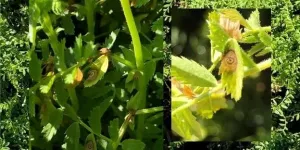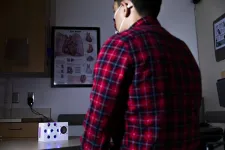Wild relatives offer a solution to devastating chickpea disease Ascochyta blight
2021-03-09
(Press-News.org) A staple for many, chickpeas are a rich source of vitamins, minerals, and fiber and offer many health benefits, such as improving digestion and reducing the risk of ailments including heart disease and cancer. However, chickpeas possess a rather narrow genetic diversity and are susceptible to Ascochyta blight, a devastating disease that can cause a yield loss of up to 100 percent. In Australia alone, this disease costs an average of $4.8 million annually.
To help curtail the impact of Ascochyta blight, plant pathologists in Western Australia have turned to wild relatives of the chickpea: Cicer reticulatum and Cicer echinospermum and found that these plants have a natural resistance to the disease. This is the first report of Ascochyta blight resistance in a novel wild Cicer collection.
"Identifying such sources of resistance is a very exciting finding for the chickpea industry and can offer growers better genetic control of the disease," explained Lars Kamphuis, one of the scientists involved with the study. "These sources of resistance can be utilized in chickpea breeding programs around the world to improve their resistance to this pathogen."
Kamphuis and his colleagues used a germplasm collection that has also been a valuable source of resistance to other diseases and pests such as root lesion nematodes and pod-borer. Using the disease scores for Ascochyta blight and genotypic information of the germplasm, they were also able to identify Ascochyta blight-associated regions in the wild Cicer genome.
"Collaborators in Australia are evaluating this resource for sources of resistance to Phytophthora root rot, acid soil, and chilling tolerance," said Kamphuis. "This novel wild Cicer germplasm is thus being mined for novel sources of biotic and abiotic stress resistance and will help improve the genetic diversity within chickpea breeding programs."
INFORMATION:
For more information about this study read "Identification of Novel Sources of Resistance to Ascochyta Blight in a Collection of Wild Cicer Accessions" published in the February issue of Phytopathology. To hear more about how Australian researcher are utilizing the wild Cicer resource to improve chickpeas listen to the podcast in the following link (https://grdc.com.au/news-and-media/audio/podcast/better-chickpeas-a-wild-idea).
[Attachments] See images for this press release:

ELSE PRESS RELEASES FROM THIS DATE:
2021-03-09
In the spring of 2020, the outbreak of the coronavirus pandemic appeared to coincide with the tree pollen season in the northern hemisphere. These observations prompted an international team of researchers to conduct an extensive investigation: The scientists wanted to know whether there is a demonstrable link between airborne pollen concentrations and SARS-CoV-2 infection rates.
Pollen is a significant environmental factor influencing infection rates
Under the leadership of first author Athanasios Damialis, the team at the Chair of Environmental Medicine at TUM collected data on airborne pollen concentrations, weather conditions and SARS-CoV-2 infections - taking into consideration the variation of infection rates from ...
2021-03-09
Depending on the topic, people's attitudes can change from moment to moment or last a lifetime. The factors that make one opinion long-lasting and another ephemeral, however, are not always clear.
Past studies have demonstrated that opinions based on hard facts and data can remain constant over time, but new research published in the journal Psychological Science reveals that attitudes based on feelings and emotions can also stand the test of time. This research has implications for both predicting whose attitudes are fixed versus fleeting and how to nudge people to form more long-lasting opinions.
"We have ...
2021-03-09
Washington, March 9, 2021--A comprehensive meta-analysis of prior research has found, overall, that children ages 1 to 8 were less likely to understand picture books when they read the digital, versus print, version. However, when digital picture books contain the right enhancements that reinforce the story content, they outperform their print counterparts. The results were published today in Review of Educational Research, a peer-reviewed journal of the American Educational Research Association.
Authors Natalia Kucirkova at the University of Stavanger in Norway and The Open University in the United Kingdom, and May Irene Furenes and Adriana G. Bus at the University of Stavanger, analyzed the results of 39 studies that included a total 1,812 children between the ages of 1 and 8. For their ...
2021-03-09
PHILADELPHIA-- Head injury in the United States is common, END ...
2021-03-09
Imagine using stem cells from your bone marrow to grow a piece of bone tissue in the lab, after which medical doctors explore which drugs have the desired effect on your bones. In this way, a tailor-made treatment plan would be made for everyone, with the best approach being clear in advance. Personalized medicine at its best.
That vision of the future is no longer science fiction now that researchers from Eindhoven University of Technology and Radboud university medical center have actually realized the first part: growing a lifelike piece of bone tissue from human stem cells. It is the first organoid of bone, a simplified version of the original, the researchers report today in the journal Advanced Functional Materials.
Coherent picture
"With ...
2021-03-09
Smart speakers, such as Amazon Echo and Google Home, have proven adept at monitoring certain health care issues at home. For example, researchers at the University of Washington have shown that these devices can detect cardiac arrests or monitor babies breathing.
But what about tracking something even smaller: the minute motion of individual heartbeats in a person sitting in front of a smart speaker?
UW researchers have developed a new skill for a smart speaker that for the first time monitors both regular and irregular heartbeats without physical contact. The system sends inaudible sounds from the speaker out into ...
2021-03-09
Nanoengineers at the University of California San Diego have developed a "wearable microgrid" that harvests and stores energy from the human body to power small electronics. It consists of three main parts: sweat-powered biofuel cells, motion-powered devices called triboelectric generators, and energy-storing supercapacitors. All parts are flexible, washable and can be screen printed onto clothing.
The technology, reported in a paper published Mar. 9 in Nature Communications, draws inspiration from community microgrids.
"We're applying the concept of the microgrid to create wearable systems that are powered sustainably, reliably and independently," said co-first author Lu Yin, a nanoengineering Ph.D. student ...
2021-03-09
Charcot-Marie Tooth disease is the most common hereditary neurological disease in the world. It affects the peripheral nerves and causes progressive paralysis of the legs and hands. No treatment is currently available to fight this disease, which is due to the overexpression of a specific protein. Scientists from the CNRS, INSERM, the AP-HP and the Paris-Saclay and Paris universities have developed a therapy based on degrading the coding RNA for this protein in mice. Their work is patented and was published on 9 March 2021 in Communications Biology.
In molecular biology, transcription is when a DNA molecule is copied to make an RNA molecule. This RNA molecule is then "translated" into a protein, which can perform different functions within the body's cells. When a specific protein called ...
2021-03-09
Modern hospitals and antibiotic treatment alone did not create all the antibiotic resistant strains of bacteria we see today. Instead, selection pressures from before widespread use of antibiotics influenced some of them to develop, new research has discovered.
By using analytical and sequencing technology that has only been developed in recent years, scientists from Wellcome Sanger Institute, University of Oslo and University of Cambridge have created an evolutionary timeline of the bacterium, Enterococcus faecalis, which is a common bacterium that can cause antibiotic resistant infections in hospitals.
The results, published today (9th March 2021) in Nature Communications ...
2021-03-09
An increase in overall hospitalizations was reported for older adults in the week following exposure to a tropical cyclone, according to a new study by researchers at Columbia University Mailman School of Public Health, Columbia University's Earth Institute and colleagues at Colorado State University and Harvard T. H. Chan School of Public Health.
The researchers used data over 16 years on 70 million Medicare hospitalizations and a comprehensive database of county-level local winds associated with tropical cyclones to examine how tropical cyclone wind exposures ...
LAST 30 PRESS RELEASES:
[Press-News.org] Wild relatives offer a solution to devastating chickpea disease Ascochyta blight

